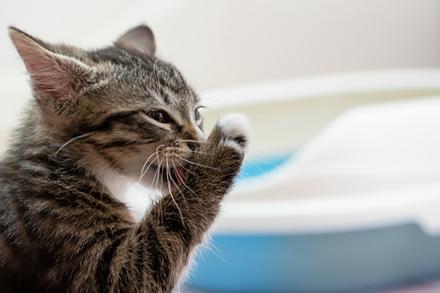Biobased Kitty Litter is the Cat’s Meow

ARS scientists have developed a biobased kitty litter made from eastern red cedar flakes, guar gum, biochar, and other biodegradable ingredients. (Photo courtesy Getty Images)
Kitty litter and red cedar flakes are probably not the first things you think of when you hear the words “agricultural research.” But for a team of Agricultural Research Service (ARS) scientists in Peoria, IL, the pairing makes perfect sense. That’s because finding new, value-added uses for agricultural commodities, including forestry products like red cedar, is the mission of ARS’s National Center for Agricultural Utilization Research (NCAUR) in Peoria.
The team’s kitty-litter research was sparked by pet-owner concerns about the potential for cats to ingest the sodium bentonite clay used as a clumping agent in traditional litters. No biobased litters have been reported to have any adverse reactions, said NCAUR plant physiologist Steve Vaughn. He and his colleagues decided to test flakes from reclaimed eastern red cedar as an alternative to the clay. The wood’s highly absorbent fibers are already used in some commercial biobased cat litters, but Vaughn's group saw room for improvement in the areas of clumping and odor control.
To achieve the latter, the researchers used a procedure called pyrolysis to convert some of the flakes into biochar. It's a carbon-rich, highly porous charcoal-like substance that can capture volatile organic compounds like MMB (3-mercapto-3-methylbutan-1-ol), the chief odor compound in cat urine.
Since biochar use can create some dust, the researchers lightly coated the material with food-grade mineral oil and glycerol. This resulted in a good reduction in the tiny (10 microns or less) dust particles that can be harmful to animal health. They achieved target clumping rates of 60 percent or more by mixing in guar gum, a common food-processing and binding agent.
Analysis showed that the resulting litter formulation performed as well as or better than several commercial biobased products. Vaughn said there were virtually no traces of MMB in the airspace immediately above litter boxes containing the experimental litter, thanks to the biochar's capture of the odor-causing compound.
The researchers published their work in 2020 in Industrial Crops and Products. They are seeking an industrial partner to further explore the commercial potential of their biobased cat litter formulations.
Vaughn's NCAUR collaborators in the effort are Mark Berhow, Jeffrey Byars, Fred Eller, Mike Jackson, Sean Liu, Jill Moser, and Steve Peterson.—By Sue Kendall, ARS Office of Communications.
You May Also Like

